Last week (September 26, 2016) I started my new position of Program Coordinator with Virginia Energy Efficiency Council, where a large portion of my job is dedicated to building coalitions of PACE (Property Assessed Clean Energy financing) supporters throughout the Commonwealth. Being relatively new to the world of PACE, I immediately immersed myself in PACE research. Therefore, imagine my excitement when I learned VAEEC was kicking off their webinar series with a “PACE in Virginia” webinar!
The webinar promised an overview of PACE financing, including benefits to contractors and property owners, case studies, and a breakdown of what PACE looks like in Virginia, presented by three speakers with amply knowledge and experience in the field. And it delivered.
I found the webinar to be incredibly beneficial. Elyssa Rothe’s (PACENation) overview reinforced the basics of PACE, which provided good background knowledge for the rest of the presentation. Abigail Johnson (Abacus Property Solutions) dove further into the benefits of PACE and provided two case studies as examples. Bill Greenleaf (Virginia Community Capital) ended the webinar with a summary of what PACE looks like in Virginia.
Here are my greatest take-aways from the webinar:
- PACE is for energy efficiency and renewables and many different building types. can be used for projects that either reduce or generate energy, including energy efficiency upgrades and renewable energy. Furthermore, it is available for all kinds of commercial building types; multi-family, hotel, office, retail, agriculture, and industrial. Government owned buildings are the only exception.
- PACE offers several advantages over traditional bank financing. It covers 100% of a project’s costs, while offering a competitive interest rate. Instead of the typical 5-7 year terms, PACE can be financed for up to 20 years, which lowers annual payments. Financing is repaid annually via the building’s property tax assessment. Additionally, assessments stay with the property and automatically transfer to a new owner.
- In Virginia, local governments must past ordinances to establish PACE programs or contract to a third party. Commercial PACE, or C-PACE, was enhanced in 2015 and applies to commercial buildings with at least 5 units.
If you were unable to attend the webinar, I urge you watch our “PACE in Virginia” webinar recording. Even if you already have a good understanding of PACE, this webinar will serve as a great refresher as you listen to experts well entrenched in the field.
Please note that we also have a PACE page on our website with updates and resources.
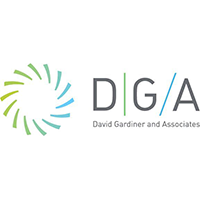 Virginia could help the industrial sector seize enormous opportunities to cut carbon emissions while saving money and making manufacturers more competitive through industrial energy efficiency. That’s according to Business Gold member David Gardiner and Associates, October’s Featured Member of the Month.
Virginia could help the industrial sector seize enormous opportunities to cut carbon emissions while saving money and making manufacturers more competitive through industrial energy efficiency. That’s according to Business Gold member David Gardiner and Associates, October’s Featured Member of the Month.
A new report by the Alliance for Industrial Efficiency (a project of VAEEC member David Gardiner and Associates) finds that Virginia could reduce carbon emissions by over 2.5 million tons annually by 2030 from industrial energy efficiency – nearly equal to the emissions from a coal-fired power plant – and save the Commonwealth’s businesses over $4 billion on their electricity bills in the process. Industrial energy efficiency could achieve nearly one-third (31 percent) of Virginia’s emission reductions called for under EPA’s Clean Power Plan. Nationwide, industrial efficiency and CHP/WHP could save more than 396 megawatt hours of electricity; 174 short tons of carbon dioxide (the equivalent of 46 coal-fired power plants); and $298 billion in utility bill savings.
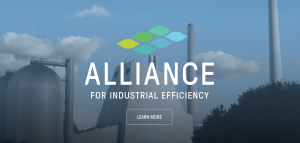 VAEEC member, David Gardiner and Associates (DGA), is an Arlington-based strategic advisory firm focused on climate change, clean energy, and sustainability that helps clients with strategic planning, research and analysis, and improved communications through partnership building and advocacy. The Alliance for Industrial Efficiency, a project of DGA, promotes state and federal policies to support U.S. manufacturing competitiveness through enhanced industrial efficiency. The Alliance’s diverse coalition of businesses, labor groups, and non-profits work to improve energy efficiency in America’s industrial sector.
VAEEC member, David Gardiner and Associates (DGA), is an Arlington-based strategic advisory firm focused on climate change, clean energy, and sustainability that helps clients with strategic planning, research and analysis, and improved communications through partnership building and advocacy. The Alliance for Industrial Efficiency, a project of DGA, promotes state and federal policies to support U.S. manufacturing competitiveness through enhanced industrial efficiency. The Alliance’s diverse coalition of businesses, labor groups, and non-profits work to improve energy efficiency in America’s industrial sector.
In September, the Alliance for Industrial Efficiency released a report ranking U.S. states by their ability to slash carbon emissions through industrial energy efficiency. As the industrial sector is the largest energy user in the U.S. economy, improving its efficiency could significantly reduce emissions in the electricity sector nationwide.
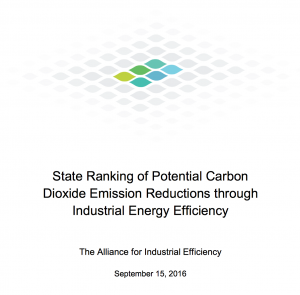 The report highlights a key tool for states looking to reduce emissions to comply with the Obama administration’s Clean Power Plan or exploring options for utility planning. It also shines a light on an opportunity for manufacturing, mining, construction, and agricultural industries to realize dramatic savings through investments in industrial energy efficiency and combined heat and power (CHP) and waste heat to power (WHP) technologies—the practice of powering and heating industrial facilities with otherwise-wasted resources and energy. Even in the absence of the Clean Power Plan, improving energy efficiency in the industrial sector makes business sense and can save industry billions of dollars in avoided energy costs.
The report highlights a key tool for states looking to reduce emissions to comply with the Obama administration’s Clean Power Plan or exploring options for utility planning. It also shines a light on an opportunity for manufacturing, mining, construction, and agricultural industries to realize dramatic savings through investments in industrial energy efficiency and combined heat and power (CHP) and waste heat to power (WHP) technologies—the practice of powering and heating industrial facilities with otherwise-wasted resources and energy. Even in the absence of the Clean Power Plan, improving energy efficiency in the industrial sector makes business sense and can save industry billions of dollars in avoided energy costs.
“This report demonstrates that we can cut carbon while saving businesses money,” said Jennifer Kefer, Executive Director, Alliance for Industrial Efficiency. “With this analysis, we have exposed the myth that clean energy and manufacturing competitiveness are in conflict. To the contrary, by investing in industrial efficiency, we can reduce emissions while simultaneously slashing utility bills, creating jobs, and strengthening our industrial sector.”
Download the Alliance’s report and fact sheets.
Guest Blog Post: Johnette Johnson, VAEEC intern and University of Richmond student
With a score of 13 points out of a possible 50 (same score as 2015), Virginia dropped two rankings from 31 to 33 in this year’s State Energy Efficiency Scorecard. According to the scorecard press release from the American Council for an Energy Efficient Economy (ACEEE), Virginia’s lower score is due to our inability to keep pace as other states expanded efficiency efforts.
Download the Virginia one-pager, the full State Energy Efficiency Scorecard and report, or the updated Virginia entry in their State and Local Database.
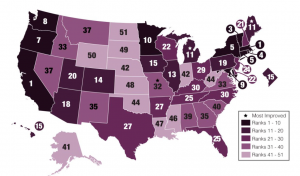 The State Scorecard is a helpful illustration of the strengths and weaknesses of each state’s energy efficiency components and provides an opportunity for all states to learn from each other.
The State Scorecard is a helpful illustration of the strengths and weaknesses of each state’s energy efficiency components and provides an opportunity for all states to learn from each other.
For instance, if we look at Virginia’s utility programs, our scoring is a negative 0.5 points out of 20, placing our utility programs at the 51st rank alongside West Virginia. Virginia’s State Corporation Committee, who regulates utility programs, allocates a very small budget towards electricity and natural gas efficiency programs thereby energy savings are some of the lowest in the country.
The ACEEE also encourages growth in Virginia’s Combined Heat and Power (CHP) sector. CHP is the successful generation of electricity and useful thermal energy in a single, integrate system that produces 80% combined efficiency as opposed to 45% for traditional power plants. However, CHP systems require the purchasing of backup power from the electric grid as well as the selling of excess electricity back to it. A lack of established parameters and procedures for connecting to the grid drives up costs and stifles CHP deployment in Virginia.
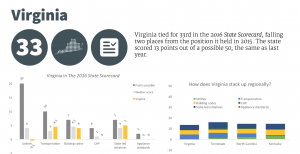 California reaps the benefits of CHP through a total of 28 installations. Another installation of note is their Self-Generation Incentive Program (SGIP) that provides incentive payments to support the commercialization of new, efficient CHP technologies. CA’s CHP energy resources are held to the standards of the Qualifying Facilities and CHP Program Settlement; the program provides targets and requirements that facilitate the efficient production of CHP.
California reaps the benefits of CHP through a total of 28 installations. Another installation of note is their Self-Generation Incentive Program (SGIP) that provides incentive payments to support the commercialization of new, efficient CHP technologies. CA’s CHP energy resources are held to the standards of the Qualifying Facilities and CHP Program Settlement; the program provides targets and requirements that facilitate the efficient production of CHP.
While highlighting other state’s successes, the Scorecard does not fail to recognize Virginia’s innovative efficiency programs. Virginia received a stellar five points out of a possible seven for state-led initiatives, ranking us 10th in the nation for these programs. This performance marks a high potential for the future of the state’s energy efficiency programs. Virginia exhibited notable performances in our building code policies as well, ranking 28th in the country.
The Scorecard can be used as a tool to motivate Virginians to take note of the Commonwealth’s energy efficiency setbacks and to push for improvements that our neighboring states are already implementing.
September 23, 2016
Chelsea Harnish, VAEEC Executive Director
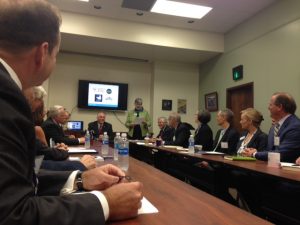 What an inspiring day at the Clean Energy Business Roundtable in Roanoke with Virginia Governor Terry McAuliffe. Plenty of VAEEC members were represented, including Community Housing Partners, Trane, Virginia Community Capital, Oracle (OPower), Appalachian Power and Siemens.
What an inspiring day at the Clean Energy Business Roundtable in Roanoke with Virginia Governor Terry McAuliffe. Plenty of VAEEC members were represented, including Community Housing Partners, Trane, Virginia Community Capital, Oracle (OPower), Appalachian Power and Siemens.
You can track some of the action via #NewVAEconomy.
A few things we heard from folks in the room:
- Governor McAuliffe kicked it off with a number of data-based arguments for energy efficiency and clean energy being cornerstones of the #NewVAEconomy, including: in 2013, the Clean Energy Census for Virginia found that clean energy- including wind, solar, EE, biomass and geothermal- was a $500,000 industry. Looking at preliminary results from our 2016 census, the revenue from this industry jumped to $2.1 billion with EE making up $1.2 billion (and the census is still open).
There was a story from the Roanoke Times that includes that first stat and some other highlights from the day.
- The cap for VA SAVES should be extended beyond $5M. Trane noted that school systems are looking to use this program, but the money will eventually run out. With the interest rate so low, schools could really do more with VA SAVES than current financing structure allows.
- Monica Rokicki with Better Building Works stated that a building-science based approach is critical for any renewable energy and energy efficiency policy decisions. We checked in with Monica after the event and got a bit more detail from her: “We have to factor in health and safety. For example, many clients think insulation is a good thing for energy efficiency in buildings. They are right except that if they don’t account for the fire hazards like air leakage at the tops of buildings or old knob and tube wiring, they are creating a very dangerous situation. Likewise, doing work without measuring before and after ventilation can create very bad air quality issues — making existing ones worse or even creating new ones. This is why independent third party verification by certified auditors is critical.” Plus, it ensures that the energy savings are on par with what we predicted.
- The Roanoke Chamber of Commerce (host of the event), emphasized the need for technical training in high schools. Many in the room agreed with this need and several stated that including facilities manager skills in these programs is key as many people in these positions are at or near retirement age with very few qualified candidates available to fill in.
- Oracle Utilities (OPower was recently purchased by Oracle), which operates worldwide, called for the Department of Mines Minerals and Energy (DMME) to get more involved in SCC proceedings.
- Community Housing Partners highlighted their workforce training programs and noted that baby boomers currently occupy a significant segment of energy-related jobs and they are starting to retire.
- Appalachian Power chimed in with the utility perspective that customers have a hard time paying their bills, so collaboration is key to ensure those who are already struggling don’t have to pay more.
A huge thanks for to the Roundtable participants for taking time out of their busy schedules to share their experiences and expertise and to Governor McAuliffe and his staff for joining and supporting the Commonwealth’s clean energy and energy efficiency industries.
We were proud to help organize the Clean Energy Business Roundtable with our partners at Advanced Energy Economy, AJW Consultants, Chambers for Innovation and Clean Energy (VAEEC member), U.S. Green Building Council (VAEEC member) and the Roanoke Regional Chamber of Commerce.
#NewVAEconomy @GovofVirginia
We expect a packed house yet again for the VAEEC Fall Meeting on November 29th and afterward at our highly anticipated inaugural Energy Efficiency Leadership Awards ceremony. This is an excellent opportunity to showcase your company or organization to leaders in Virginia’s energy efficiency industry.
Get the latest information on the sponsorship levels here.
 #EEDay2016
#EEDay2016
On October 5, 2016, a network of groups and partners across the country will join together to promote the benefits of energy efficiency, for the first-ever, nationwide, Energy Efficiency Day campaign. This social media and press effort aims to raise awareness among the public and media by organizing participants to share related content, stories and concrete examples of the positive impact of energy efficiency.
- Highlight positive, nonpartisan messaging about energy efficiency
- Show the positive impact of energy efficiency across a range of energy users
- Share concrete, effective ways to save energy and money
Opportunities to Participate:
Government, corporate, and industrial partners can help support Energy Efficiency Day 2016 by sharing appropriate content and reaching out to the media on and before October 15, 2016. Help amplify the campaign’s energy efficiency messages via your communications channels:
- Use the campaign’s sample social media posts and memes (or your own) to direct visitors to energy efficiency tips on your own website.
- Write and post a blog about your energy efficiency success story, tips, or stories ahead of the 2016 Energy Efficiency Day.
- Issue your own press statement urging your audiences to save energy, save money.
- Promote your own energy efficiency success stories during and after the campaign.
You can download the Energy Efficiency Day toolkit here and access tons of other resources (sample content, logos, etc) online.
We encourage all VAEEC members to take part in Energy Efficiency Day through whatever appropriate means, including using #EEDay2016 in social media, pitching reporter contacts and reaching out to your customers/members/supporters via email leading up to and on October 5.
The inaugural Energy Efficiency Day is a collaborative effort of regional and national organizations working to promote energy efficiency. Participating organizations include:
- Advanced Energy Economy
- Alliance to Save Energy (VAEEC member)
- American Council for an Energy-Efficient Economy
- Appliance Standard Awareness Project
- Climate Nexus
- E4theFuture (VAEEC member)
- Keystone Energy Efficiency Alliance
- Midwest Energy Efficiency Alliance
- Northeast Energy Efficiency Partnerships
- Northwest Energy Efficiency Alliance
- NRDC
- Resource Media
- Sierra Club (VAEEC member)
- Southeast Energy Efficiency Alliance
- South-Central Partnership for Energy Efficiency as a Resource
- Southwest Energy Efficiency Project
A number of other companies and organizations have already expressed interest in participating in Energy Efficiency Day 2016. A full list of supporters (updated frequently) is available here.
This blog post was written by David Cohan, Building Energy Codes Program Manager at the U.S. Department of Energy, originally posted to the Office of Energy Efficiency and Renewable Energy website in May 2016, and republished on vaeec.org with permission.
I recently got back from Louisville, Kentucky, where I was representing DOE in the latest round of energy code development hearings. While the people who participate in the development process know energy codes inside and out, I know they are not as clear to the broader public. So let’s take a step back. Here’s a primer on what energy codes are, how they are developed, adopted, and enforced, and what DOE’s role is in these processes. Future blog posts in this series will zoom into specific topics.
First, here are a few key points:
1. CODE DEVELOPMENT
How it works: National model energy codes are developed by two private organizations, ASHRAE and the International Codes Council. ASHRAE develops the model commercial energy code, known as 90.1. The International Code Council develops the International Energy Conservation Code (IECC), which contains chapters for both residential and commercial buildings. Any interested party can participate in the development processes by submitting proposals to change the code and commenting on others’ proposals. The codes cycle is continuous, with new codes being developed every three years. Final versions of each new edition are determined by a vote of the 90.1 committee members for ASHRAE and by the International Code Council membership for the IECC.
DOE’s role: DOE participates in both the ASHRAE and ICC development processes, but has no special status. DOE develops and submit code change proposals that strive to make cost-effective, energy efficient upgrades to current model codes. After each new model code is published, DOE also must determine if the new version saves energy relative to the old version.
Note: David Cohan has another blog worth reading on this topic, “How are Building Energy Codes Developed” from August 2016.
2. CODE ADOPTION
How it works: Most codes are adopted at the state level, though, in about 10 states they are adopted by cities. State adoption can occur directly by legislative action, or through regulatory agencies authorized by the legislature. Cities adopt codes through their mayors, councils, or committees depending on their form of government. Once adopted, the code becomes law within the particular state or local jurisdiction.
DOE’s role: DOE provides technical assistance to state and local governments to support their adoption processes. DOE responds to state and local requests and it also develops customized reports for every state detailing the benefits of upgrading to the current model codes. To ensure that its information is used effectively, DOE works with the Regional Energy Efficiency Organizations (REEOs) and the National Association of State Energy Officials (NASEO) who have connections in almost every state and often participate directly in the adoption processes. DOE support also includes tracking state adoption status, coordinating activities among stakeholders, and technical analysis.
3. CODE COMPLIANCE
How it works: The key to realizing the full savings potential of building energy codes is by ensuring that builders are complying with them. Design and construction professionals are most likely to comply with the code when they are given education and training, particularly after a new code is adopted. Enforcement is almost always done by building permit office staff at the local (city) level who typically review plans first to ensure they are compliant and then conduct field inspections to verify that the plans are being followed during construction.
DOE’s role: DOE develops and regularly updates software (REScheck and COMcheck) to simplify and clarify compliance with model energy codes and standards, as well as a number of state-specific energy codes. DOE also develops education and training materials that are available free and used by governments, organizations and trainers across the country.
DOE has also developed an affordable methodology for states and cities to determine energy and dollar savings opportunities associated with increased energy code compliance in single-family homes. Field studies based on the methodology have already been implemented in nine states with more underway. The data that comes from these studies helps focus education and training programs and provides a basis for utilities and states to determine whether such programs will be cost-effective. DOE is currently developing a parallel methodology for the commercial sector.
By: Kelsey Galantich, VAEEC Intern 2016
Electricity is essential to remain connected in this day and age. There have even been acts at the international level to make electricity a human right. However, in an article recently released by The Atlantic, even in the United States affordable electricity can be hard to come by.
Most middle to upper class families spend 5% or less of their incomes on energy-related bills.[1] However, according to the article, the lower the income of the family, the higher percentage of income is spent on electricity. Data from the Department of Health and Human Services estimates that people below 50% of the poverty level consequently spend, on average, about 35% of their incomes on home energy costs in the U.S.1
For a better perspective, the map below, created by Inside Energy’s Jordan Wirfs-Brock, compares the percent of income spent on energy bills for homes below 50% of the poverty level within the continental US:
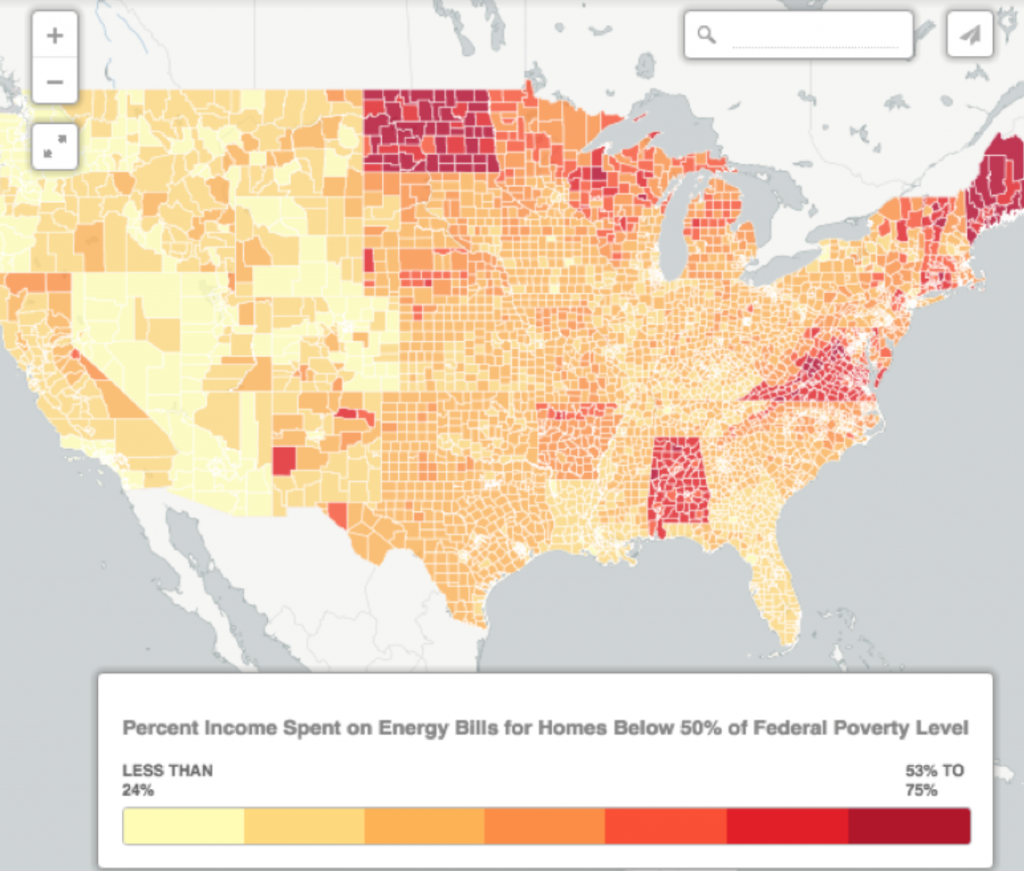
Below, is a closer look at the state of Virginia:[2]
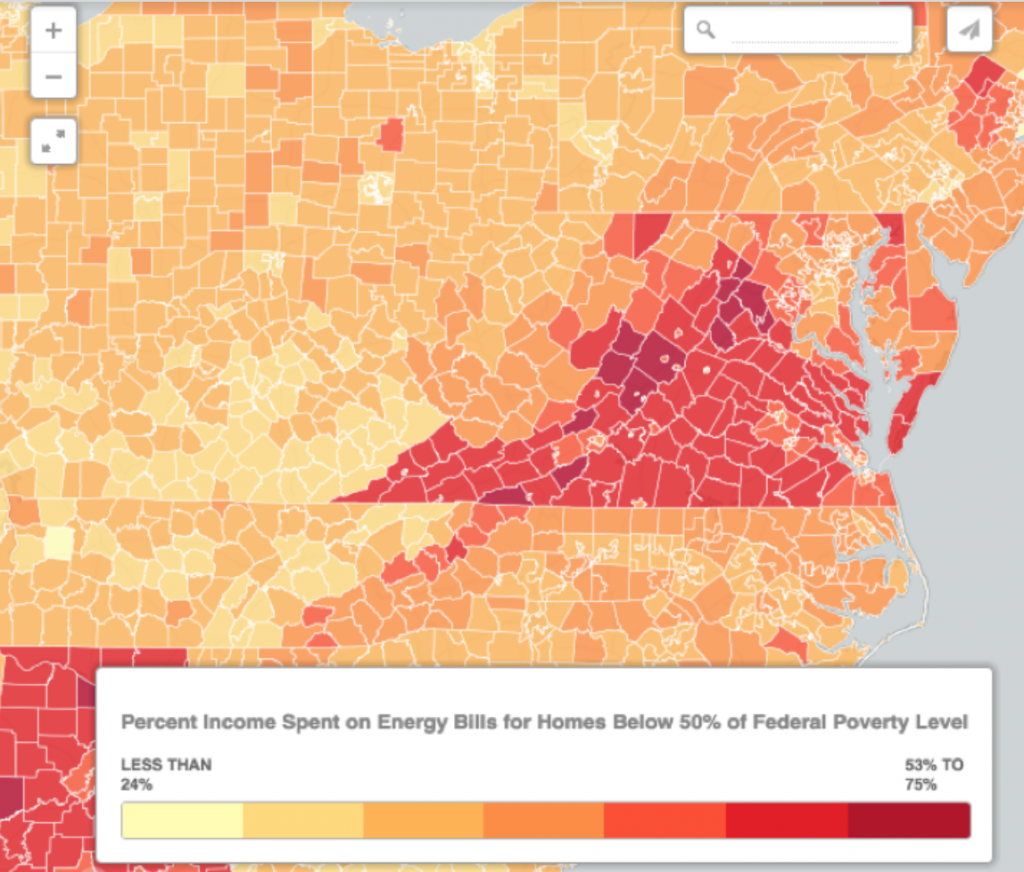
As a solution, Virginia legislators have made efforts to move forward with the federally funded Property Assessed Clean Energy (PACE) financing program. This program allows businesses to finance solar energy and energy efficiency improvements at no upfront cost, and to then pay back the cost over time with the inevitable money saved in energy bills via their property tax bill. The program is slowly moving forward in some Virginia localities, such as VAEEC Council member, Arlington County. However, though available to homeowners in other states, its expansion to private homeowners is not yet a reality in Virginia.
According to the American Council for an Energy Efficient Economy, many state utility regulators require that utilities provide bill assistance programs that complement federal programs, such as the Weatherization Assistance Program (WAP) and the Low Income Home Energy Assistance Program (LIHEAP), both of which are conducted through the U.S. Department of Energy. Some regulations also require utilities with energy efficiency programs to specifically target low-income customers [3]. For example, in Virginia, Dominion Power offers bill pay assistance and free weatherization and energy-saving upgrades through its EnergyShare program, which targets customers facing financial hardships, including military veterans and disabled individuals [4]. The program also includes one-on-one sessions with program participants, and educational outreach at community events to help people make wiser energy decisions. Similarly, another VAEEC member, the Local Energy Alliance Program (LEAP) offers free in-home energy assessments by expert building 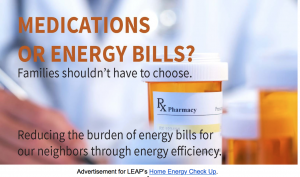 analysts for Dominion customers, which are available to households with an income threshold of 60% of the state median income, households with elderly and disabled citizens and Veterans, and Dominion EnergyShare customers. These analysts provide a custom report recommending energy saving products, free installment of selected improvements, and post-installment visits to ensure improvements’ success [5]. Community Housing Partners yet another VAEEC member, located in Christiansburg, VA offers weatherization services through WAP, which involve a site-specific energy audit of the home, along with repairs and improvements, such as the installation of energy-saving measures. This service targets low-income families, in particular those with elderly residents, disabled individuals, and children [6].
analysts for Dominion customers, which are available to households with an income threshold of 60% of the state median income, households with elderly and disabled citizens and Veterans, and Dominion EnergyShare customers. These analysts provide a custom report recommending energy saving products, free installment of selected improvements, and post-installment visits to ensure improvements’ success [5]. Community Housing Partners yet another VAEEC member, located in Christiansburg, VA offers weatherization services through WAP, which involve a site-specific energy audit of the home, along with repairs and improvements, such as the installation of energy-saving measures. This service targets low-income families, in particular those with elderly residents, disabled individuals, and children [6].
Increased energy efficiency is essential to making electricity more affordable and accessible. These national and local initiatives have the potential to help millions of low-income Americans keep the lights on while also staying fed, offering hope for a more efficient, cleaner, and sustainable communities at reduced cost, no matter the income.
Does your utility, nonprofit or company offer programs or opportunities for families in need in Virginia to reduce the burden of their energy bills? Let us know by emailing info@vaeec.org and we’ll update this post!
[1] http://www.theatlantic.com/business/archive/2016/06/energy-poverty-low-income-households/486197/
[2] These maps are based on original analysis by independent firm, Accounting Insights, who shared their data with Inside Energy. The annual energy bills were determined by information regarding energy use, type, and price from the Energy Information Administration, and information on household size, tenure, type of fuel used from the U.S. Census Bureau. This information was compiled into a model that estimated the annual energy cost for each U.S. county. Inside Energy then divided the average annual energy bill by the income midpoint for households living under 50% of the federal poverty level to come up with the percent of income owed to energy bills.
[3] http://aceee.org/sites/default/files/publications/researchreports/u1602.pdf
[4] https://www.dom.com/residential/dominion-virginia-power/in-the-community/energyshare
[5] http://leap-va.org/saveaton/
[6] https://www.communityhousingpartners.org/312/weatherize.html
On September 7 we hosted a conference call to answer questions about our upcoming VAEEC Energy Efficiency Leadership. Below you’ll find a rough transcript of that Q&A. Please direct additional questions about the awards to info@vaeec.org.
- What should we expect at VAEEC’s First Annual Awards Ceremony?
We first wanted to see what type of applicants we would get- we received 2 dozen. We have two application categories: One for business and one for projects.
The type of sector your organization works in will help determine the award categories. The decision will be made by the Selection Committee. The selection committee is made up of 6 people- 3 members and 3 board members.
The application process closes Friday October 14th. The Selection Committee will convene and will have a chance to review all applications to discuss criteria and our nominees in each category. We really want to showcase as many companies as possible and show how much work is going on in Virginia. It’s important that we highlight as many companies as possible.
- The nomination application process seems simple and wants applicants to list out goals and outcomes of their project. Is that all you want to know?
Yes, we researched what other awards applications looked for and they are very similar.
- Do the nominees and specific projects have to be in Virginia?
The company does not have to be headquartered in Virginia, but they should have an office in Virginia. For projects, yes, it has to be in Virginia. The project already be completed.
- Is there a minimum requirement for how long a project has been completed?
No requirements.
- When is the Application Deadline?
Friday October 14th
- What does the Selection Committee process look like?
The staff will package applications for the Selection Committee to review once the application process closes on October 14th. The Selection Committee will convene 2 meetings: one in late October and one in early November.
Grading sheets will be used so that each project and company will be graded based upon the same merits. The Selection Committee will then come back for a second meeting during the first week of November to discuss grades and choose winners. The staff will then reach out to award winners to make sure someone from the company can attend the Awards Ceremony.
- When will you notify the winner?
We will notify winners the second or third week of November- definitely before Thanksgiving.
- When and where is the Awards Ceremony?
The Awards Ceremony will take place at the University of Richmond on November 29, 2016 from 4:30pm-6pm, immediately following the VAEEC biannual member meeting.
Schedule:
1:00-400pm Member Meeting
4:30-6:00pm Awards Ceremony
We want this to be a more laid back and networking atmosphere where energy efficiency industry representatives can celebrate our collective efforts in the energy efficiency field.
We are also looking for sponsors for the full day. We plan to announce our sponsor packages sometime next week. Award winners and nominees will be able to sponsor the event if they so choose.
- Is there a ticket cost to get into the ceremony?
We’re doing something new this Fall and will be charging non-members for the member meeting. The Awards Ceremony will be free of charge. Overall the purpose of the meeting will be to raise awareness for the Council and to celebrate energy efficiency efforts in Virginia. We are excited to showcase the work you all have done in the state.
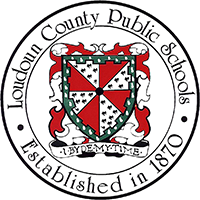 Thanks to Loudoun County Public Schools (LCPS) Energy & Environment Team Administrators John Lord and Michael Barancewicz for submitting their energy efficiency success story. September 2016.
Thanks to Loudoun County Public Schools (LCPS) Energy & Environment Team Administrators John Lord and Michael Barancewicz for submitting their energy efficiency success story. September 2016.
Their success:
LCPS is the third largest school division in the Commonwealth of Virginia. LCPS serves more than 78,000 students in 89 facilities. Since 1993, LCPS has implemented an energy management program in partnership with Cenergistic. This partnership revolutionized how our district views, consumes and uses energy. The LCPS behavioral-focused energy conservation and efficiency program – THE LCPS ENERGY & ENVIRONMENT TEAM — is focused on changing behaviors to realize significant savings. Since 1993, LCPS has saved over $70 Million on energy costs, reduced CO2 emissions by over 352,000 metric tons, and kept dollars that may have otherwise been spent to pay unnecessarily high energy bills available to be spent for a much better purpose – teaching children. Due in part to the efforts of this team, LCPS won First Place in the Virginia School Boards Association’s 2011 Green Schools Challenge and has earned the EPA ENERGY STAR Partner of the Year Award for 2010 & 2011 as well as 2012, 2013, 2014, 2015 & 2016 EPA ENERGY STAR Partner of the Year – Sustained Excellence Awards.
Tell us more about your story:
 The LCPS Energy & Environment Team uses both energy efficiency and energy conservation to accomplish the goal of ensuring efficient and effective stewardship of public resources through continually striving to reduce district energy use and cost without negatively impacting health and safety, the educational environment or productivity.
The LCPS Energy & Environment Team uses both energy efficiency and energy conservation to accomplish the goal of ensuring efficient and effective stewardship of public resources through continually striving to reduce district energy use and cost without negatively impacting health and safety, the educational environment or productivity.
Energy Conservation is the ability to capitalize on behavioral practices which allow LCPS to simply use less energy with existing resources. The tools used include: ingenuity, resourcefulness, discipline, procedures, volunteerism, and all the things that make people great.
Energy Efficiency is the ability to capitalize on new technologies and equipment that will accomplish desired outcomes while using less energy. Giving people more efficient tools allows those who are already conserving to use less energy when energy needs to be expended.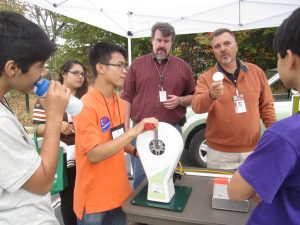
By using both conservation and efficiency methods, the greatest possible success is achieved. However, our real strength is the team itself. At over 90,000 individuals, the LCPS Energy & Environment Team includes all students, staff, parents and other community members who make up the totality of individuals who utilize LCPS sites. By having everyone take part, an empowering alliance in the school system has been created that keeps energy costs within our control.
Find out more about the LCPS Energy & Environment Team.
What was the problem or opportunity you identified?
LCPS had a need for additional funds to use in the classroom and those funds were not forthcoming through “traditional” means. The LCPS Energy & Environment Team has been a consistent success in focusing the expenditure of taxpayer dollars on instruction.
How has this impacted your clients/constituents/
members?
LCPS has saved enough money on energy to buy a new middl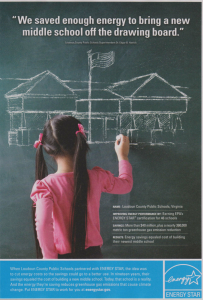 e school.
e school.
The ENERGY STAR program thought the LCPS success story was worthy of nationwide promotion and ran the ad at right in Fortune Magazine in 2013. Ultimately, students benefit and that is what LCPS does – through our example, we are teaching the value of both economic and environmental stewardship.
What challenges did you face along the way?
LCPS has been doing this work for over 20 years; the challenges have been many and complex. Growth of the district has been intense as LCPS has tripled in size over this time. Changes in leadership and the cost per unit of energy can provide both opportunities and challenges. As Jim Collins said: “Good is the enemy of great. And that is one of the key reasons why we have so little that becomes great.” Simply focusing on not allowing ourselves to be good enough has probably been the greatest hurdle. Continuing to grow, evolve, innovate and adapt through changing times is never easy.
In what ways could this have implications for Virginia’s energy efficiency landscape?
If every school district could save over 28% on its energy costs, as LCPS has been able to do for the last 20 years, the effect would be astounding. Choosing to take the LCPS approach has positive implications for people, the planet, and proficiency of students.
What’s the next step for you?
The LCPS Energy & Environment Team has begun using social media to help educate folks and get the message out, feel free to follow us on Twitter @LCPSeeteam. LCPS continues to focus on certifying more of our building as ENERGY STAR schools. We have moved from seven certified in 2008 to fifty-five certified in 2015. We expect to have even more in 2016. Constant vigilance and laser focus on the small details will be how we move forward.
What “lessons learned” would you share with other VAEEC members?
Imagine an old man out in the country rocking in his chair on his front porch. Beside him, his faithful dog snoozing on the porch next to him. Each day the neighbor would walk by, and most days it is peaceful and calm, but from time to time the dog’s tail slips under the rocker. The dog lets out a horrible wail and clearly is in pain, but shortly he settles back into dreamland next to the old man. One day the neighbor asks him: “Why doesn’t your dog just move?” The old man responds: “Don’t hurt enough yet.” Our advice is don’t wait until it hurts too much not to move; move as soon as you can. Failure to act or delay in taking action has a cost that can never be recovered. There is no time but now!
Want to learn even more about LCPS success? Contact:
John Lord & Michael Barancewicz
Energy Education Specialists
Loudoun County Public Schools
1002-C Sycolin Road, SE | Leesburg, VA 20175
(571) 252-2960
eeteam@lcps.org





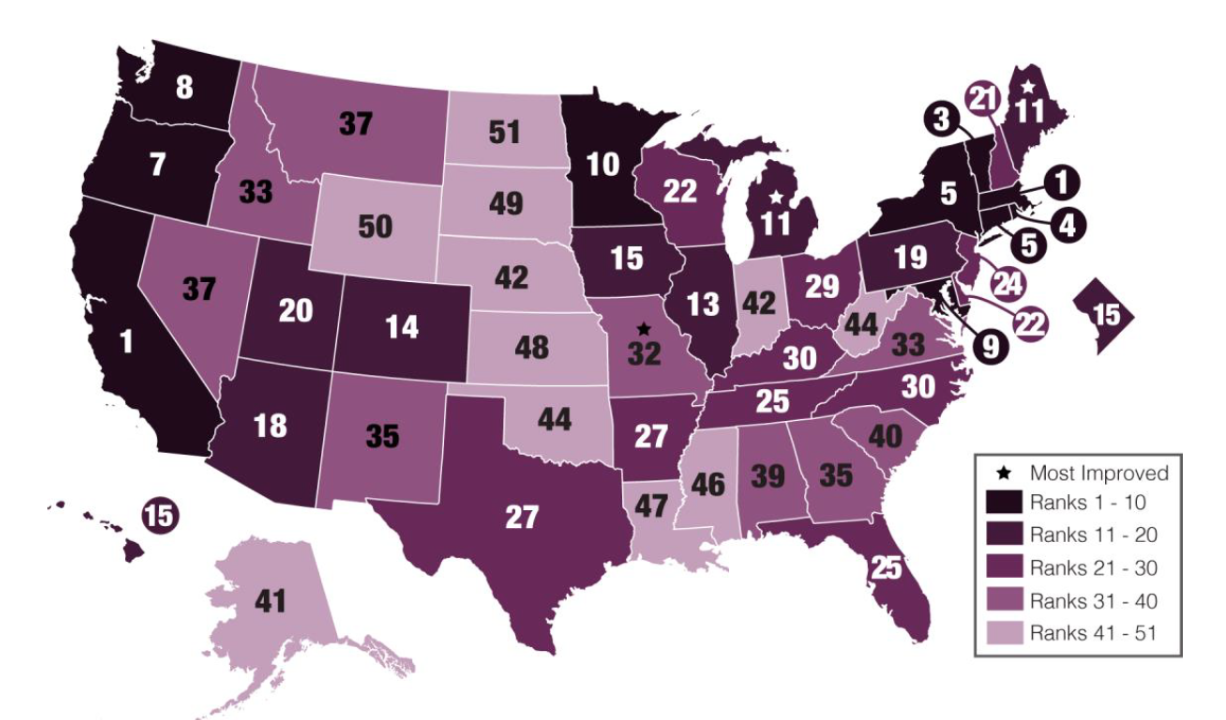
 The State Scorecard is a helpful illustration of the strengths and weaknesses of each state’s energy efficiency components and provides an opportunity for all states to learn from each other.
The State Scorecard is a helpful illustration of the strengths and weaknesses of each state’s energy efficiency components and provides an opportunity for all states to learn from each other. California reaps the benefits of CHP through a total of 28 installations. Another installation of note is their Self-Generation Incentive Program (SGIP) that provides incentive payments to support the commercialization of new, efficient CHP technologies. CA’s CHP energy resources are held to the standards of the Qualifying Facilities and CHP Program Settlement; the program provides targets and requirements that facilitate the efficient production of CHP.
California reaps the benefits of CHP through a total of 28 installations. Another installation of note is their Self-Generation Incentive Program (SGIP) that provides incentive payments to support the commercialization of new, efficient CHP technologies. CA’s CHP energy resources are held to the standards of the Qualifying Facilities and CHP Program Settlement; the program provides targets and requirements that facilitate the efficient production of CHP.
 What an inspiring day at the Clean Energy Business Roundtable in Roanoke with Virginia Governor Terry McAuliffe. Plenty of VAEEC members were represented, including Community Housing Partners, Trane, Virginia Community Capital, Oracle (OPower), Appalachian Power and Siemens.
What an inspiring day at the Clean Energy Business Roundtable in Roanoke with Virginia Governor Terry McAuliffe. Plenty of VAEEC members were represented, including Community Housing Partners, Trane, Virginia Community Capital, Oracle (OPower), Appalachian Power and Siemens.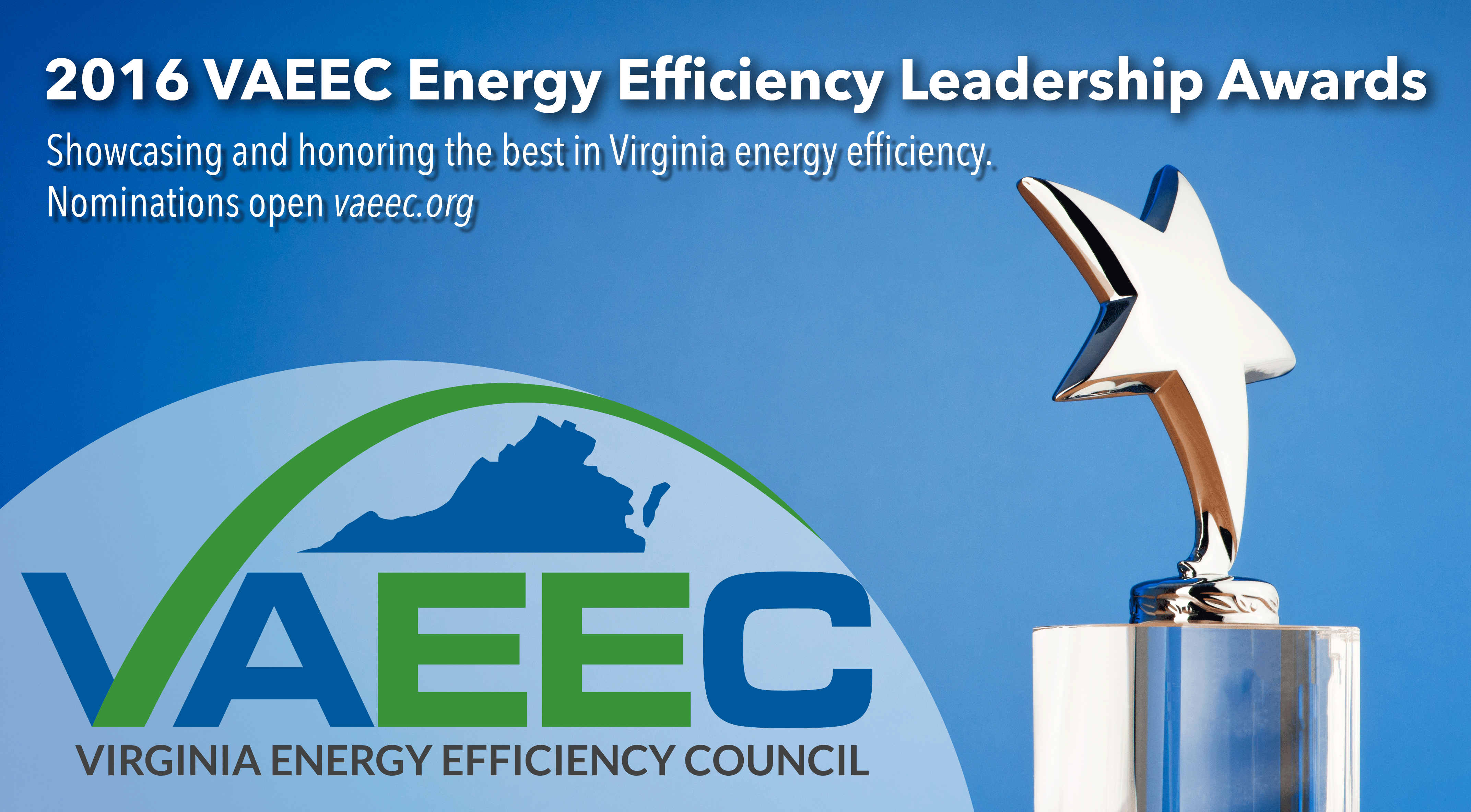

 #EEDay2016
#EEDay2016

 analysts for Dominion customers, which are available to households with an income threshold of 60% of the state median income, households with elderly and disabled citizens and Veterans, and Dominion EnergyShare customers. These analysts provide a custom report recommending energy saving products, free installment of selected improvements, and post-installment visits to ensure improvements’ success [5].
analysts for Dominion customers, which are available to households with an income threshold of 60% of the state median income, households with elderly and disabled citizens and Veterans, and Dominion EnergyShare customers. These analysts provide a custom report recommending energy saving products, free installment of selected improvements, and post-installment visits to ensure improvements’ success [5]. 
 The
The 
 e school.
e school.